Patterns of geographic variation of thermal adapted candidate genes in Drosophila subobscura sex chromosome arrangements
- PMID: 29699488
- PMCID: PMC5921438
- DOI: 10.1186/s12862-018-1178-1
Patterns of geographic variation of thermal adapted candidate genes in Drosophila subobscura sex chromosome arrangements
Abstract
Background: The role of chromosomal arrangements in adaptation is supported by the repeatable clinal variation in inversion frequencies across continents in colonizing species such as Drosophila subobscura. However, there is a lack of knowledge on the genetic variation in genes within inversions, possibly targets of climatic selection, across a geographic latitudinal gradient. In the present study we analysed four candidate loci for thermal adaptation, located close to the breakpoints, in two chromosomal arrangements of the sex (A) chromosome of Drosophila subobscura with different thermal preferences. Individual chromosomes with A2 (the inverted arrangement considered warm adapted) or AST (the standard ancestral arrangement considered cold adapted) were sequenced across four European localities at varying latitudes, up to ~ 2500 Kms apart.
Results: Importantly, we found very low differentiation for each specific arrangement across populations as well as no clinal patterns of genomic variation. This suggests wide gene exchange along the cline. Differentiation between the sex chromosome arrangements was significant in the two more proximal regions relative to the AST orientation but not in the distal ones, independently of their location inside or outside the inversion. This can be possibly due to variation in the levels of gene flux and/or selection acting in these regions.
Conclusions: Gene flow appears to have homogenized the genetic content within-arrangement at a wide geographical scale, despite the expected diverse selective pressures in the specific natural environments of the different populations sampled. It is thus likely that the inversion frequency clines in this species are being maintained by local adaptation in face of gene flow. The differences between arrangements at non-coding regions might be associated with the previously observed differential gene expression in different thermal regimes. Higher resolution genomic scans for individual chromosomal arrangements performed over a large environmental gradient are needed to find the targets of selection and further elucidate the adaptive mechanisms maintaining chromosomal inversion polymorphisms.
Keywords: Chromosomal arrangements; Climatic selection; Clinal variation; Drosophila subobscura; Gene flow; Genetic differentiation; Geographic variation; Thermal adaptation; UTR variation.
Conflict of interest statement
Ethics approval and consent to participate
Not applicable.
Competing interests
The authors declare that they have no competing interests.
Publisher’s Note
Springer Nature remains neutral with regard to jurisdictional claims in published maps and institutional affiliations.
Figures
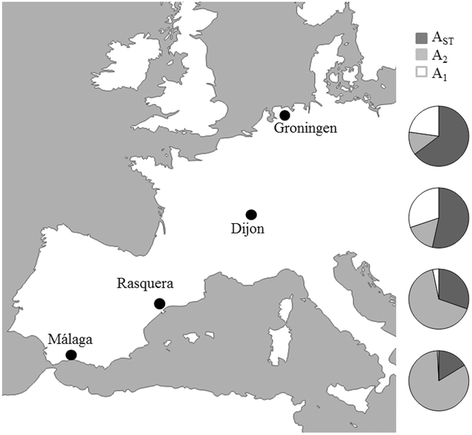
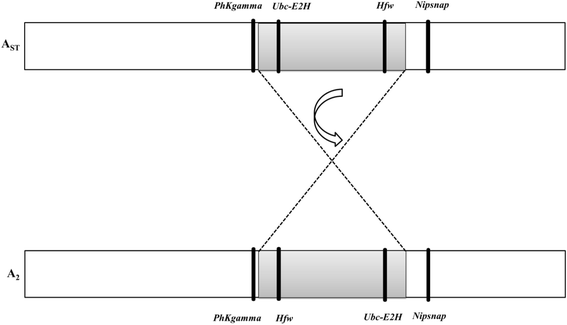
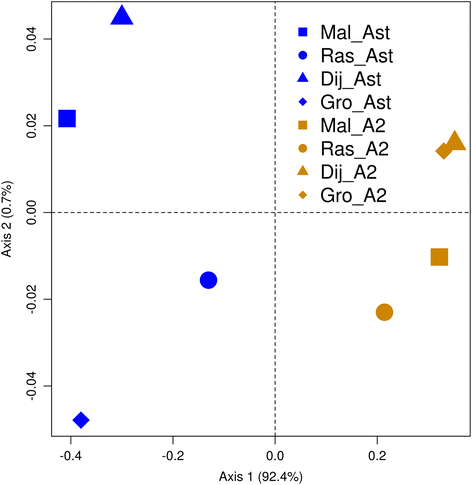
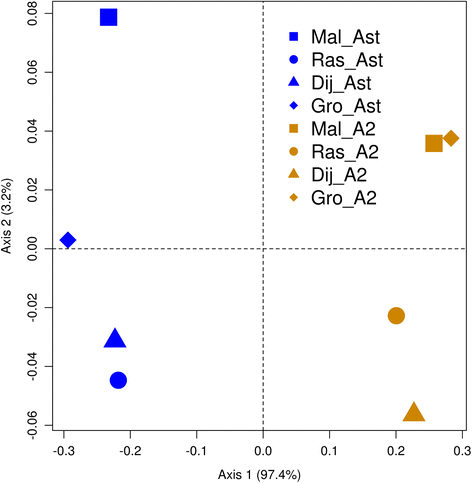
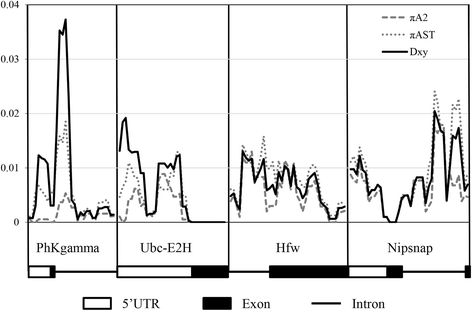
Similar articles
-
Basal hsp70 expression levels do not explain adaptive variation of the warm- and cold-climate O3 + 4 + 7 and OST gene arrangements of Drosophila subobscura.BMC Evol Biol. 2020 Jan 31;20(1):17. doi: 10.1186/s12862-020-1584-z. BMC Evol Biol. 2020. PMID: 32005133 Free PMC article.
-
Clinal patterns of chromosomal inversion polymorphisms in Drosophila subobscura are partly associated with thermal preferences and heat stress resistance.Evolution. 2010 Feb 1;64(2):385-97. doi: 10.1111/j.1558-5646.2009.00835.x. Epub 2009 Sep 9. Evolution. 2010. PMID: 19744119
-
The genetic content of chromosomal inversions across a wide latitudinal gradient.PLoS One. 2012;7(12):e51625. doi: 10.1371/journal.pone.0051625. Epub 2012 Dec 18. PLoS One. 2012. PMID: 23272126 Free PMC article.
-
Worldwide latitudinal clines for the alcohol dehydrogenase polymorphism in Drosophila melanogaster: what is the unit of selection?EXS. 1997;83:97-115. doi: 10.1007/978-3-0348-8882-0_6. EXS. 1997. PMID: 9342845 Review.
-
Population and behaviour genetics of Drosophila ananassae.Genetica. 1996 May;97(3):321-9. doi: 10.1007/BF00055318. Genetica. 1996. PMID: 9081860 Review.
Cited by
-
How chromosomal rearrangements shape adaptation and speciation: Case studies in Drosophila pseudoobscura and its sibling species Drosophila persimilis.Mol Ecol. 2019 Mar;28(6):1283-1301. doi: 10.1111/mec.14923. Epub 2018 Dec 10. Mol Ecol. 2019. PMID: 30402909 Free PMC article.
-
Basal hsp70 expression levels do not explain adaptive variation of the warm- and cold-climate O3 + 4 + 7 and OST gene arrangements of Drosophila subobscura.BMC Evol Biol. 2020 Jan 31;20(1):17. doi: 10.1186/s12862-020-1584-z. BMC Evol Biol. 2020. PMID: 32005133 Free PMC article.
-
Distribution modelling of an introduced species: do adaptive genetic markers affect potential range?Proc Biol Sci. 2020 Sep 30;287(1935):20201791. doi: 10.1098/rspb.2020.1791. Epub 2020 Sep 16. Proc Biol Sci. 2020. PMID: 32933443 Free PMC article.
-
Predicting Thermal Adaptation by Looking Into Populations' Genomic Past.Front Genet. 2020 Sep 25;11:564515. doi: 10.3389/fgene.2020.564515. eCollection 2020. Front Genet. 2020. PMID: 33101385 Free PMC article. Review.
-
Temporal and habitat adaptations in Drosophila subobscura populations: changes in chromosomal inversions.Genetica. 2025 Apr 25;153(1):16. doi: 10.1007/s10709-025-00232-9. Genetica. 2025. PMID: 40278938 Free PMC article.
References
-
- Prevosti A, Ribo G, Serra L, Aguade M, Balanyà J, Monclus M, et al. Colonization of America by Drosophila subobscura: experiment in natural populations that supports the adaptive role of chromosomal-inversion polymorphism. Proc Natl Acad Sci U S A. 1988;85:5597–5600. doi: 10.1073/pnas.85.15.5597. - DOI - PMC - PubMed
Publication types
MeSH terms
Substances
Grants and funding
- SFRH/BPD/36829/2007/Fundação para a Ciência e a Tecnologia/International
- SFRH/BPD/86186/2012/Fundação para a Ciência e a Tecnologia/International
- project CTM2013-48163/Spanish Government/International
- CTM2017-88080 (AEI/FEDER, UE)/Spanish Government/International
- research groups SGR2014-336/Generalitat de Catalunya/International
LinkOut - more resources
Full Text Sources
Other Literature Sources
Molecular Biology Databases

